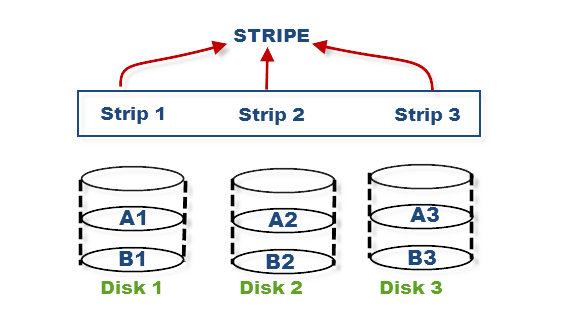Performance optimization using RAID striping and mirroring involves leveraging the strengths of both techniques to balance speed and data redundancy.
-
RAID Striping (RAID 0) splits data into stripes and writes these stripes across multiple drives simultaneously. This parallelism significantly enhances read and write performance because multiple disks are accessed at once. The stripe size (the length of data segments written to each disk) and stripe width (number of disks involved) are key parameters to tune for optimal throughput. However, RAID 0 offers no redundancy, so a single drive failure results in data loss.
-
RAID Mirroring (RAID 1) duplicates data exactly on two or more disks, providing fault tolerance. Read performance can improve since any read request can be served by any mirrored disk, potentially summing read throughput. Write performance, however, is generally limited to the speed of the slowest disk because data must be written to all mirrors. RAID 1 is ideal when reliability and read speed are priorities over write speed or storage efficiency.
-
Combining Striping and Mirroring (RAID 10) merges the benefits of both: data is striped across mirrored pairs. This configuration offers high fault tolerance (can survive multiple drive failures if not in the same mirror) and improved performance. RAID 10 is particularly suited for workloads demanding both high IOPS and redundancy, such as large databases or transaction processing systems. Adding more mirror pairs can further increase IOPS and reduce latency.
-
Cache Mirroring Impact: Write cache mirroring, used in many RAID controllers to protect against controller failure, can introduce latency and reduce performance because each write must be mirrored in cache before acknowledgement. This overhead can slow down write operations and reduce effective cache size by half.
-
Tuning Considerations: Performance depends on workload characteristics such as read/write request sizes, number of concurrent files written, and file system fragmentation. For example, read-ahead optimizations benefit workloads where writes and allocations are equal to or larger than the stripe size and when files are written sequentially.
In summary, RAID striping boosts throughput by parallelizing disk access, mirroring enhances reliability and read speed, and RAID 10 combines both for balanced high performance and fault tolerance. Proper tuning of stripe size, cache settings, and understanding workload patterns are essential to maximize performance gains.



















WebSeoSG offers the highest quality website traffic services in Singapore. We provide a variety of traffic services for our clients, including website traffic, desktop traffic, mobile traffic, Google traffic, search traffic, eCommerce traffic, YouTube traffic, and TikTok traffic. Our website boasts a 100% customer satisfaction rate, so you can confidently purchase large amounts of SEO traffic online. For just 40 SGD per month, you can immediately increase website traffic, improve SEO performance, and boost sales!
Having trouble choosing a traffic package? Contact us, and our staff will assist you.
Free consultation